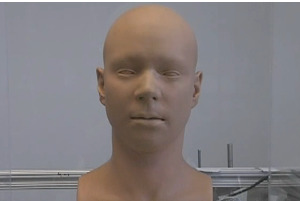 He’s not good-looking and he doesn’t get around much, but the “talking head” the National Institute for Occupational Safety and Health (NIOSH) is about to start using in its respiratory fit research is pretty articulate.
He’s not good-looking and he doesn’t get around much, but the “talking head” the National Institute for Occupational Safety and Health (NIOSH) is about to start using in its respiratory fit research is pretty articulate.
Simulated speech is one of the factors that will let NIOSH’s National Personal Protective Technology Laboratory (NPPTL) determine how well a respirator fits a face that moves and speaks.
The new robotic manikin headform, developed in collaboration with Air Force Research Laboratory and Biomedical Advanced Research and Development Authority (BARDA), “ will greatly expand the opportunities for research into respirator inward leakage: ways in which respirator wearers may be exposed to various aerosol particles that could penetrate through the respirator or creep in through the sides as they go about their work,” according to NIOSH.
Simulates worker movements
The measurements of 3,997 individuals (1,013 of whom had their facial measurements taken with a laser scanner) were used to create five digital headform sizes. The robotic talking head, built by Hanson Robotics, Inc., performs head movements, as well as the lip and jaw movements of speech, in order to simulate the exercises a worker performs during a respirator fit test.
Researchers engineered a way for the headforms to recite the “rainbow passage,” a poetic string of words describing prisms of light and a pot of gold that models all possible movements of the human mouth.
Five million respirator users
“Over five million Americans are required to wear respirators in their workplace,” says Dr. Maryann D’Alessandro, Director of NPPTL. “The talking head is an innovative scientific advance that offers transformational promise to better understanding respiratory protection and respirator fit for an increasingly diverse workforce.”
The talking head incorporates both art and science to emulate the human form. It is covered in silicone elastomer artificial skin which offers several special characteristics that allow for it to mimic the skin on a human face:
- First, the softness of the material compares well to that of human facial tissues, and elongates or stretches in a way similar to human skin;
- Second, because the material is a porous material, it is able to be compressed in a similar manner as the fluid-filled cellular material of the human face, reproducing natural creases and folds;
- Thirdly, this artificial skin has specified tissue depths for different locations of the face, similar to the inner workings of the human face.
Never gets tired
According to Ziqing Zhuang, Ph.D., a research team leader at NIOSH, the robotic talking head can be beneficial for respirator fit evaluation research because it does not require human subject review board clearance, nor does it experience weight changes or fatigue.
“The talking head will be used to research potential respirator leakage using biological aerosols such as the HIN1 influenza,” says Dr. Zhuang. “Development of this robotic headform was needed for these types of studies because older type headforms, which usually had hard surfaces or were covered only with a thin skin of plastic or rubber, could not form a good respirator seal to the face.”
Focus will be on N95 respirators
NIOSH will focus on using the talking head with certified N95 filtering facepiece respirators (FFRs) for the initial fit evaluation research. NIOSH-approved N95 respirators are commonly used in the healthcare industry to reduce exposure to respiratory pathogens like influenza. Preliminary evaluation results from an early prototype of the headform show the usefulness of headforms with skin-like surfaces as a tool for gauging respirator fit among different FFR models. Research is ongoing to determine the correlation of N95 FFRs fit on the talking headform compared with how they fit on people.
To view a video of the “talking head” please visit: http://youtu.be/ek6aJ8D5xsg
To view the NIOSH science blog on the headform please visit: http://blogs.cdc.gov/niosh-science-blog/2013/07/25/headforms/
For more information on the use of headforms in NIOSH research, please see: http://www.cdc.gov/niosh/npptl/topics/respirators/headforms/ and http://www.cdc.gov/niosh/topics/anthropometry/



